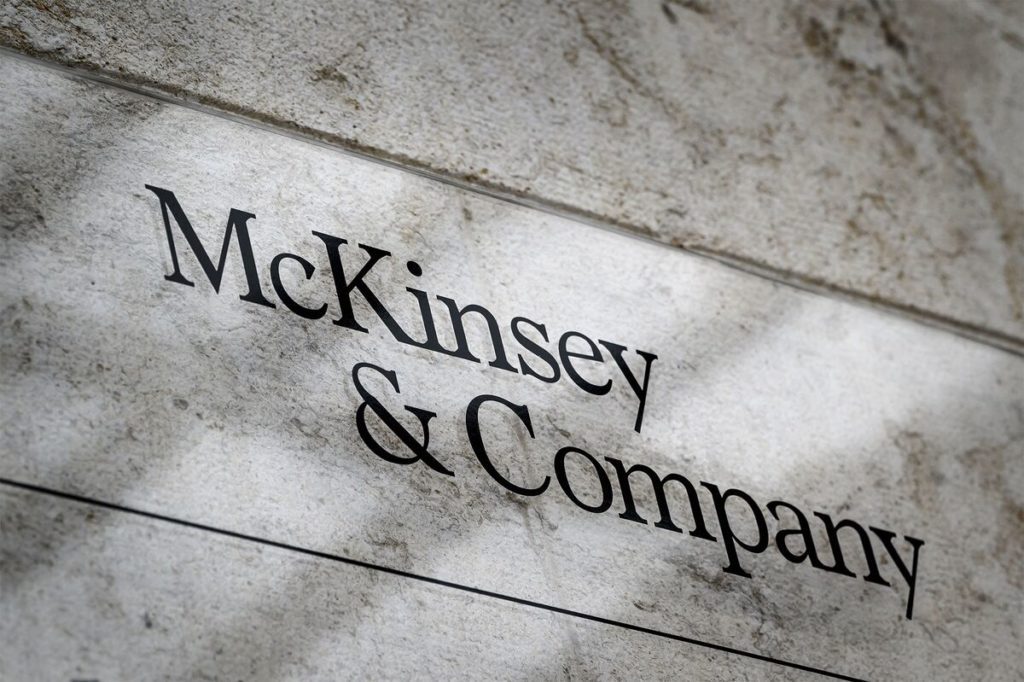Think about it.
You are an accountant in 1926.
And you see many inefficiencies in the businesses you work with.
So you decide to leave your job and start a consultancy in an era when nobody knows what “consultant” means.
Fast forward 30 years.
The firm you started has so much influence, it’s the consultant of US President Eisenhower and invents the Chief of Staff position.
It shapes how major businesses make decisions in different industries.
And your consultants even come up with the Universal Product Code (used on barcodes) to change how product tracking works forever.
It sounds like a movie.
But that’s what McKinsey did.

Now the question is obvious.
What happened in those 30 years?
How did McKinsey manage to get so much influence as a service business in the pre-computer era?
Here’s the ironic part.
Today everybody knows the McKinsey name.
But the person who made McKinsey what it is today was a new hire more than founder James McKinsey.
Marvin Bower joined McKinsey in 1933.
And the company had two years of turmoil after James McKinsey passed away in 1937.
But Bower got the support of other partners and resurrected the company with a new structure as McKinsey & Company.
Now, Bower was obsessed with McKinsey’s reputation for being a trusted and capable advisor.
So he wanted all the McKinsey consultants to behave a certain way.
And he wrote his principles to share with employees, teach to new hires, and recite them at any opportunity.
The first principle was this.
Every consultant had to put the client’s interests before McKinsey’s revenues.
Besides that, every consultant had to tell the truth even when it challenges a client’s opinion.
And every consultant had to keep client affairs secret.
He also set certain terms to call things when talking to clients.
Client work became engagements.
McKinsey became The Firm.
But he didn’t stop there.
He knew The Firm’s success was dependent on its employees.
So he created a policy to only hire the best students from the best universities.
The Firm indoctrinated those brilliant talents with Bower’s principles from the first day.
Successful ones were promoted.
And the ones who didn’t live by Bower’s principles were let go.

Imagine all of these from a client’s perspective.
You hire this company.
All employees are not only smart and hard-working, but they also behave in a particular way.
They use certain words as if it’s a cult.
They challenge the way you work.
They come up with bold ideas.
And they never talk about their other clients or the work they’ve done for them.
You’d probably be impressed.
And recommend them to your business owner friends, and hire them again.
Well, that’s how McKinsey built its influence.
And it became a household brand that created the management consultancy category.
Bower’s principles still drive McKinsey today — they are on McKinsey’s website.
In the meantime, The Firm has $15+ billion in revenue and its clients represent 20% of global GDP growth.
When principles become the brand
Let me confess something.
I used to think all those values and mission statements companies talked about were bullshit.
And I still think nobody cares about a company’s mission.
Do you know IKEA’s mission?
Probably not.
And you don’t have to.
But values are different.
Because values can be felt by customers and clients.
McKinsey clients feel Bower’s principles when they interact with their consultants.
You feel Bezos’ customer obsession when you interact with Amazon.
That’s why values might be the most important ingredient of a brand.
There is a famous quote attributed to Peter Drucker.
“Culture eats strategy for breakfast.”
It’s true but it misses one thing.
Culture eats strategy for breakfast only if the strategy doesn’t design the culture.
Bower’s strategy intentionally designed the culture of McKinsey.
And his principles built the McKinsey brand he wanted.

So how can you use values to build a brand that drives business results?
Two important points to use brand values to build a winning brand:
1. Mean it
All companies claim they have values these days.
But you can go to ten random company websites and see similar values like sustainability, empathy, or authenticity.
Do they all have the same principles?
Or do they just do it so their executive team can tick a checkbox and tell everybody they have values?
And don’t get me wrong.
These are all noble values.
But only if you mean it.
Otherwise, they stay as a fluffy word on a website — they don’t help you build a real brand.
Listen to this.
Hyposwiss is a private bank from Switzerland.
And one of their principles is honesty.
Now, it sounds like one of those fluffy brand values.
Every other bank claims that.
Plus people stopped believing most banks’ promises about investment returns or risk management after the 2008 crisis.
So in 2010, Hyposwiss decided to make their first advertising campaign in 120 years to show people that they mean it:

Bold and memorable, isn’t it?
It immediately stood out among other banks’ same old boring ads.
That’s how you attach value to a brand.
We talked about how Patagonia told people “Don’t buy this jacket” on Black Friday.
Because they truly believe in sustainability.
That’s what they stand for.
Sustainability defines the way they design jackets, allocate resources, or build a supply chain.
They mean it.
So it’s not about what your values are.
But it’s about to what extent your values change the way you do things.
That’s how your brand becomes believable.
And that’s how you truly differentiate a business.
2. Adapt to change, but preserve the core
Walt Disney started his journey with cartoons.
A decade later, he turned cartoons into full-length animation.
But technology kept developing fast.
So Mickey Mouse Club came on television in the 1950s.
Around the same years, Walt Disney went to a theme park with his daughter one day.
It was not fun.
He was disgusted with the dirtiness of the park and the behavior of the employees.
So he decided to bring the Disney magic into the physical world with Disneyland.
After he died, Disney kept growing.
International operations, cruise lines, streaming…
So where am I getting at?
Technology, specific goals, and processes always change.
And we all know only companies who adapt to change survive.
But here’s the caveat.
In his book Build to Last, Jim Collins says companies that stay successful for decades have a unique combination of preservation and change.
Yes, they continuously adopt new goals, new processes, new technology…
But they also preserve their core values.
And they make the changes in line with their principles.
Disney went through all those changes through the decades.
But they preserved their core values — creative imagination, attention to detail, and Disney Magic.
And that’s how Disney stayed Disney.
We could say Walt Disney, Marvin Bower, or Steve Jobs all created an ideology for their companies.
It’s as if they don’t have customers but believers.
And the believers buy from it, defend it, and share it.
So do the same.
Build an ideology for your brand and preserve it.
Sometimes the way you do things matters more than what you do.
–
Enjoyed this article?
Then you’ll love the How Brands Win Newsletter.
Get the “5 Mental Models to Differentiate Your Business” guide when you join. It’s free.
